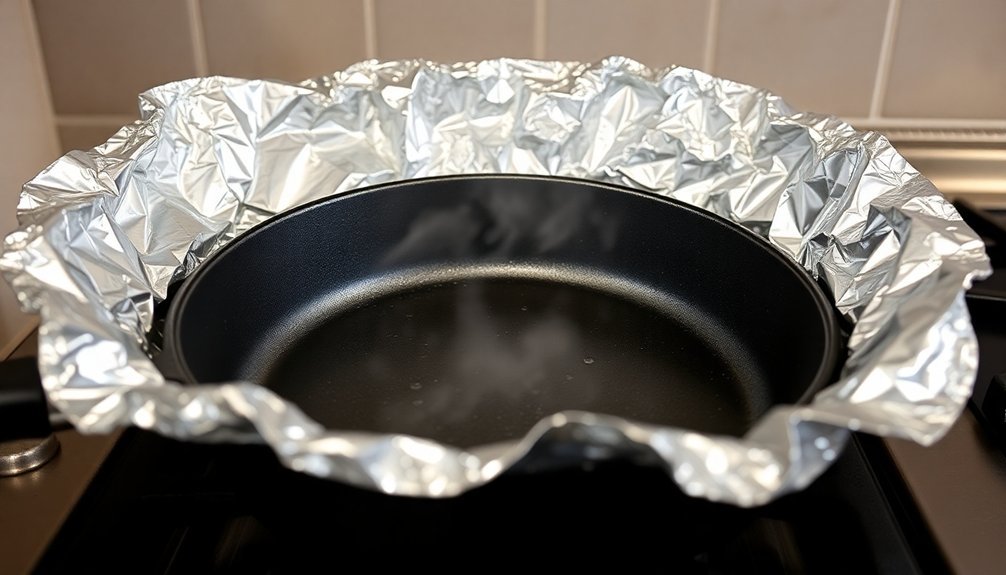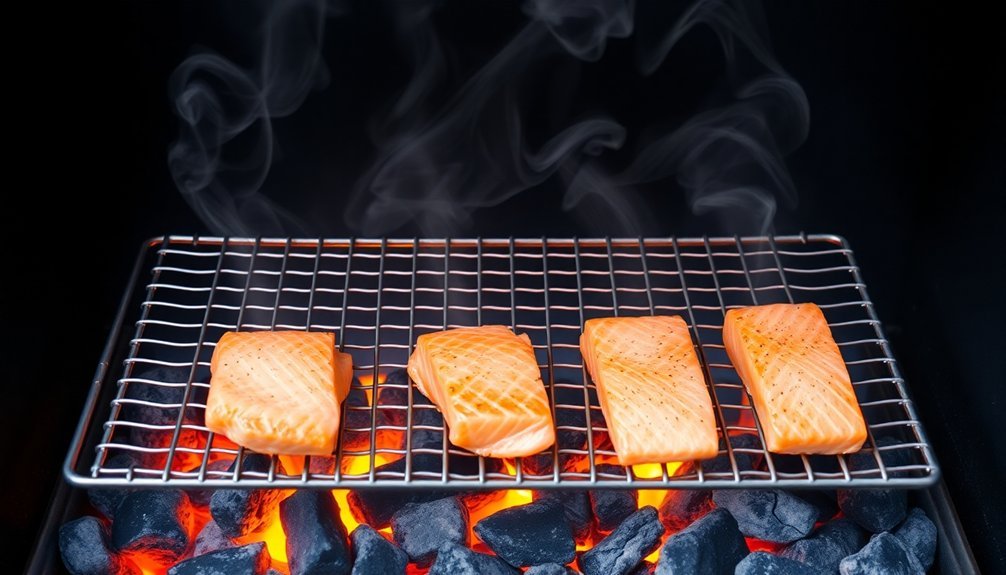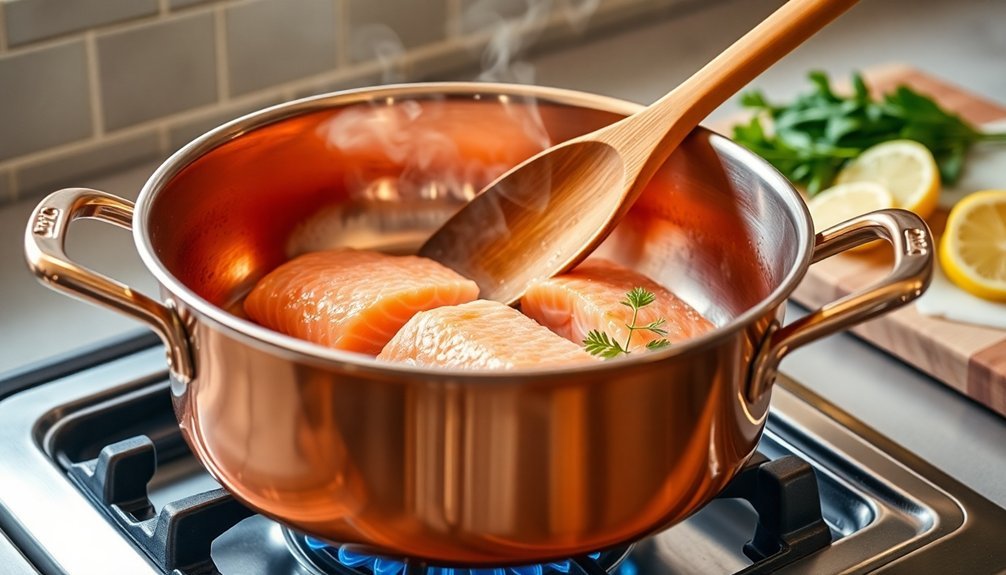You'll achieve more consistent cooking results by implementing three key heat distribution techniques. First, use reflective surfaces like aluminum foil or shiny metal panels to direct and concentrate heat where needed. Second, position your food strategically by utilizing different rack levels – top racks for broiling, middle for even baking, and bottom for thorough cooking of large cuts. Third, adjust your cooking distance based on food thickness and desired outcome, moving items closer or farther from heat sources as needed. These proven methods will enhance your cooking efficiency and boost flavor, but there's much more to discover about mastering heat control.
Reflecting Surfaces for Heat Control

When cooking with heat-reflective surfaces, you'll find they play a crucial role in controlling and concentrating thermal energy. By using materials like polished metal, mirrors, or aluminum foil, you can direct heat exactly where you need it for more efficient cooking.
Adding four reflector panels to your cooking setup will significantly increase the amount of heat concentrated on your food. You'll get the best results by keeping your reflective surfaces clean and shiny, as this improves their ability to concentrate sun rays. If you're using a solar cooker, consider adding multiple reflector panels or choosing a parabolic design to focus heat more effectively at a single point.
These surfaces work through various heat transfer methods, including radiation, convection, and conduction, to help you achieve more uniform cooking temperatures.
Whether you're using a commercial solar oven or creating a DIY cooking setup, properly positioned reflective surfaces will help you maintain consistent heat distribution.
Multiple Heat Source Positioning
To achieve ideal cooking results, you'll need to strategically position your food in relation to multiple heat sources.
The top rack works best for broiling and browning thin foods like fish or garlic bread, while the middle rack offers balanced heat perfect for casseroles, baked goods, and sheet pan dinners.
When you're cooking large cuts of meat or need a crispy bottom crust, use the bottom rack to harness the intense heat from the lower element.
Since heat naturally rises, keeping track of temperature variations at different rack levels is crucial for perfect results.
If you're using multiple racks simultaneously, stagger your dishes in the top and bottom thirds of the oven to guarantee proper airflow.
You'll want to test your oven for hotspots by baking bread slices first, and don't hesitate to adjust rack positions during cooking to get the perfect level of doneness.
Adjustable Distance Cooking Methods

Mastering adjustable distance cooking transforms your grilling and cooking precision through strategic heat control and platen spacing. You'll get ideal results by adjusting cooking surfaces based on your food's thickness and desired outcome.
For precise cooking, position your food at varying distances from heat sources. With kamado grills, use high positions for achieving color and char, while lower positions deliver extreme heat. The proper management of three key elements – oxygen, heat, and fuel – ensures optimal fire control.
When using adjustable platens, compress meat to 75-90% of its initial thickness during the first stage, then increase to 87-97% in later stages.
You can create multiple heat zones using half-moon deflectors, allowing simultaneous searing and slow-roasting. For direct heat, keep food close and cook quickly; for indirect heat, maintain distance and cook slowly.
This approach guarantees even heat distribution and prevents over or undercooking.
Frequently Asked Questions
How Do Different Cooking Oils Affect Heat Distribution During High-Temperature Cooking?
You'll find oils with higher smoke points distribute heat more evenly during high-temp cooking, while lower smoke point oils break down quickly, becoming unstable and creating uneven heating patterns in your dishes.
Can Adding Liquid Ingredients Help Balance Temperature Variations in Large Dishes?
Yes, you'll find that adding liquids helps balance temperatures in large dishes. They efficiently conduct heat, ensuring even cooking throughout. Liquids also maintain moisture and prevent hot spots while distributing heat uniformly.
Does the Material of Cooking Vessels Impact Heat Distribution Effectiveness?
Yes, your cooking vessel's material greatly impacts heat distribution. You'll get better results with copper or aluminum cookware, while stainless steel alone can create hot spots. Multi-layered vessels offer the best performance.
What Role Does Food Arrangement Play in Achieving Uniform Cooking Temperatures?
You'll achieve uniform cooking by spacing foods evenly, using single layers, and rotating items during cooking. Don't overcrowd your cooking surface, and guarantee food pieces are similar in size for consistent heating.
How Does Kitchen Ventilation Affect Overall Cooking Temperature Consistency?
Your kitchen's ventilation directly impacts cooking temperatures by removing excess heat and moisture. When you've got proper airflow, it'll prevent hot spots, maintain steady temperatures, and help you achieve more consistent cooking results.
In Summary
You'll find these three heat distribution techniques essential for achieving consistent cooking results. Whether you're using reflective materials to redirect heat, positioning multiple burners strategically, or adjusting your food's distance from heat sources, you've now got reliable methods to eliminate hot spots and cold zones. Put these approaches into practice, and you'll notice a marked improvement in your cooking's evenness and quality.





Leave a Reply